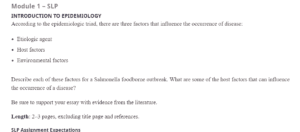Salmonella Foodborne Outbreak
Describe each of these factors for a Salmonella foodborne outbreak. What are some of the host factors that can influence the occurrence of a disease?
In recent years, epidemiologists have suggested several illness causation models. The epidemiologic triangle or triad is one of the most straightforward and traditional paradigms to describe diseases’ environmental factors, etiologic agents, and host factors (Herrmann & Johnson-Walker, 2018). Based on the epidemiologic triad framework, illness occurs from the contact between a susceptible host and an infectious agent in the environment. The environment is a medium that supports the transfer of the infectious agent from the origin or source to the vulnerable host. The causes of all diseases – including bacterial, viral, and parasitic – can be explained in terms of the three elements of the triad. One such disease is Salmonella foodborne (or food poisoning), which the CDC estimates affects more than 1 million Americans yearly.
Do you need an original version of “Salmonella Foodborne Outbreak”? Get in touch with us.
Etiologic Agent
The term etiologic agent describes the pathogen or infectious microorganism that causes a disease. It can be a microbe, a parasite, a bacterium, a virus, or an infectious pathogen (CDC, 2020). The microorganism or etiologic agent that causes the Salmonella foodborne disease is the Salmonella bacteria, which are gram-negative bacilli (rod-shaped) that belong to the Enterobacteriaceae family. The foodborne disease caused by the Salmonella species, including S. enteritidis, S. Typhi, and S. bongori, is often commonly referred to as salmonellosis and is characterized by vomiting, fever, diarrhea, and abdominal pain or cramps, appearing 12-36 hours after a host is exposed to the pathogen (Su & Chiu, 2007). Over 2,500 known species of Salmonella can cause salmonellosis, and the most common ones in the U.S. include S. Typhimurium and S. enteritidis. The former is also common in most sub-Saharan African countries and causes typhoid, one of the region’s few leading causes of death. However, several other noninvasive and harmless species of Salmonella do not necessarily cause illnesses and foodborne symptoms.
Host Factors
The term’ host’ refers to the human being who gets the infection. Several risk factors (or those aspects intrinsic to the host) can affect a person’s susceptibility, exposure, and reaction to the pathogen or etiologic factor. For Salmonella foodborne disease, several human practices can predispose them to infection (CDC, 2020). The Salmonella bacterium is typically a zoonotic disease, meaning it exists in poultry, fish, and beef. Therefore, it can exist in the feces of several animals and, thus, can contaminate human food sources like eggs, milk, as well as their meat. In addition, fecal water contamination during food preparation or processing can spread the pathogen to processed foods, fruits, spices, seafood, or vegetables. Failing to wash hands, kissing pets, and contacting infected humans can also increase the risk (Iannelli, 2019).
Thus, the two primary processes that can help to prevent the spread of bacteria from the contaminated food sources to the human host include refrigeration and cooking. Therefore, drinking water that is not boiled, unpasteurized milk, and improperly cooked meat can predispose people to Salmonella foodborne infection. Other host factors that increase the risk of developing the disease include age, with seniors aged above 65, children aged below 5, and people who are a weakened/compromised immune system, such as those with sickle cell and HIV, having the highest risk (Thompson et al., 2013).
Environmental Factors
Environmental factors/elements refer to the extrinsic/external aspects that influence the replication or development of the agent, subsequently influencing the risk of exposure. Therefore, one environmental factor that can increase the risk of the host getting into contact with the pathogen is the presence of poultry, reptiles, and pet amphibians, such as chickens, frogs, lizards, turtles, and so on (CDC, 2020). Climatic conditions and significantly warmer climates are other factors that can encourage the growth of Salmonella species.
Other Related Post: Capital Structures Financial Plan
References
CDC. (2020). Salmonella and food. https://www.cdc.gov/foodsafety/communication/salmonella-food.html
Herrmann, J. A., & Johnson-Walker, Y. J. (2018).Beyond one heath: From recognition to results. John Wiley & Sons.
Iannelli, V. (2019). Causes and risk factors of Salmonella. Very Well Health. Retrieved from https://www.verywellhealth.com/salmonella-causes-risk-factors-2633811#:~:text=Foodborne%20Salmonella%20Infection&text=Fecal%20contamination%20of%20water%20or,are%20used%20when%20cooking%20poultry.
Su, L. H., & Chiu, C. H. (2007). Salmonella: clinical importance and evolution of nomenclature. Chang Gung Medical Journal, 30(3), 210–219.
Thompson, C. N., et al. (2013). Epidemiologic features and risk factors of Salmonella gastroenteritis in children in Ho Chi Minh City, Vietnam. Epidemiology and Infection, 141(8), 1604-1613.
ORDER A PLAGIARISM-FREE PAPER HERE
We’ll write everything from scratch
Question
Module 1 – SLP
INTRODUCTION TO EPIDEMIOLOGY
According to the epidemiologic triad, three factors influence the occurrence of disease:

Salmonella Foodborne Outbreak
- Etiologic agent
- Host factors
- Environmental factors
Describe each of these factors for a Salmonella foodborne outbreak. What are some of the host factors that can influence the occurrence of a disease?
Be sure to support your essay with evidence from the literature.
Length: 2–3 pages, excluding title page and references.
SLP Assignment Expectations
Assessment and Grading: Your paper will be assessed based on the performance assessment rubric. You can view it under Assessments at the top of the page. Review it before you begin working on the assignment. Your work should also follow these Assignment Expectations.
Privacy Policy | Contact

